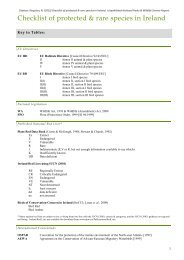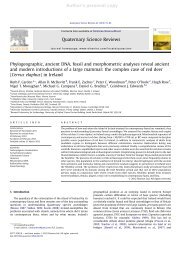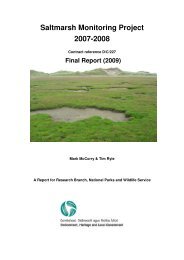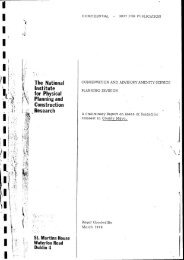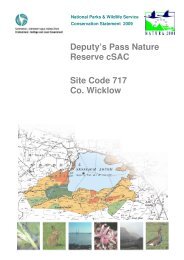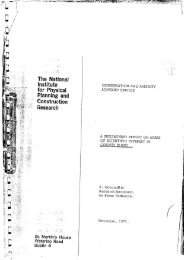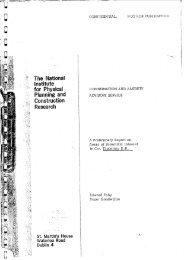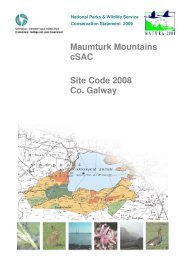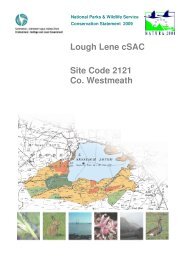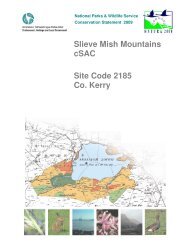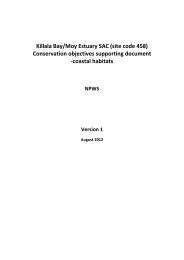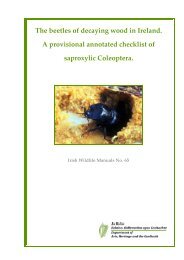The Role of Kelp in the Marine Environment - National Parks ...
The Role of Kelp in the Marine Environment - National Parks ...
The Role of Kelp in the Marine Environment - National Parks ...
Create successful ePaper yourself
Turn your PDF publications into a flip-book with our unique Google optimized e-Paper software.
<strong>The</strong> reported decrease <strong>of</strong> Cod Gadus morhua <strong>in</strong> <strong>the</strong> diet <strong>of</strong> Cormorants probably<br />
reflects <strong>the</strong> decrease <strong>in</strong> <strong>the</strong> Norwegian Cod population (Lorentsen et al., 2004) that <strong>in</strong><br />
turn is l<strong>in</strong>ked to kelp harvest<strong>in</strong>g and its negative effects on juvenile recruitment<br />
(Sjøtun & Lorentsen, 2003). However, <strong>the</strong>re is no current evidence that Cormorant<br />
populations are <strong>in</strong> decl<strong>in</strong>e due to kelp harvest<strong>in</strong>g, although longer-term population<br />
studies will be useful to monitor <strong>the</strong> effects <strong>of</strong> kelp harvest<strong>in</strong>g (Lorentsen et al., 2004)<br />
No clear relationship between Shags and kelp forests have been previously described.<br />
Sandeels Ammodytes mar<strong>in</strong>us are a favoured prey item and <strong>the</strong>se are thought to occur<br />
predom<strong>in</strong>antly on sandy or gravel substrata (Wanless et al., 1997), also <strong>the</strong> nursery<br />
grounds <strong>of</strong> this fish species. While Shags feed <strong>in</strong> deeper waters than Cormorants (21-<br />
40m: Wanless et al., 1991) <strong>the</strong>y also occur <strong>in</strong> areas <strong>of</strong> shallow rocky coast and prey<br />
upon fish and crustaceans (Cramp & Simmons, 1977; Ferns, 1992). Fur<strong>the</strong>r, Sandeels<br />
have been recorded with<strong>in</strong> Norwegian kelp forests (Hoeiaseter & Fossaa, 1993).<br />
Interactions between Shags and kelp forests are <strong>the</strong>refore likely.<br />
Members <strong>of</strong> Anatidae family that may feed with<strong>in</strong> kelp forests along Irish coasts are<br />
seaducks such as <strong>the</strong> Common Eider Somateria mollissima, Common Scoters<br />
Melanitta nigra and Red Breasted Merganser Mergus serrator, all <strong>of</strong> which feed <strong>in</strong><br />
<strong>in</strong>shore waters particularly at low tide when <strong>the</strong> bottom is easier to reach (Ferns,<br />
1992). Sea ducks are thought to prefer rocky substratum communities that are <strong>of</strong>ten<br />
dom<strong>in</strong>ated by vegetation such as kelp (Bustnes & Systad, 2001a). In particular, <strong>the</strong><br />
rare Steller’s Eider Polysticta stelleri (not found <strong>in</strong> Ireland) is noted to prefer forag<strong>in</strong>g<br />
with<strong>in</strong> kelp forests (Lam<strong>in</strong>aria hyperborea) <strong>of</strong> nor<strong>the</strong>rn Norway although kelp<br />
distribution alone, cannot expla<strong>in</strong> <strong>the</strong> distribution <strong>of</strong> this w<strong>in</strong>ter<strong>in</strong>g seaduck (Bustnes<br />
& Systad, 2001b).<br />
<strong>The</strong> Irish breed<strong>in</strong>g distribution <strong>of</strong> Common Eider extends westwards around <strong>the</strong><br />
coastl<strong>in</strong>e from <strong>the</strong> Copeland Islands, Co. Down to Inishmurray <strong>in</strong> Co. Sligo with some<br />
additional nest locations recorded e.g., Inishkeeragh, Co. Mayo (Murray & Cabot,<br />
2002). Common Eiders feed predom<strong>in</strong>antly on molluscs and crustaceans but will also<br />
prey upon crabs and starfish (Lack, 1986; Ferns, 1992). Common Scoters will feed<br />
upon crustaceans and gobies and similar to <strong>the</strong> Red Breasted Merganser, are not<br />
solely restricted to rocky reef areas.<br />
36



